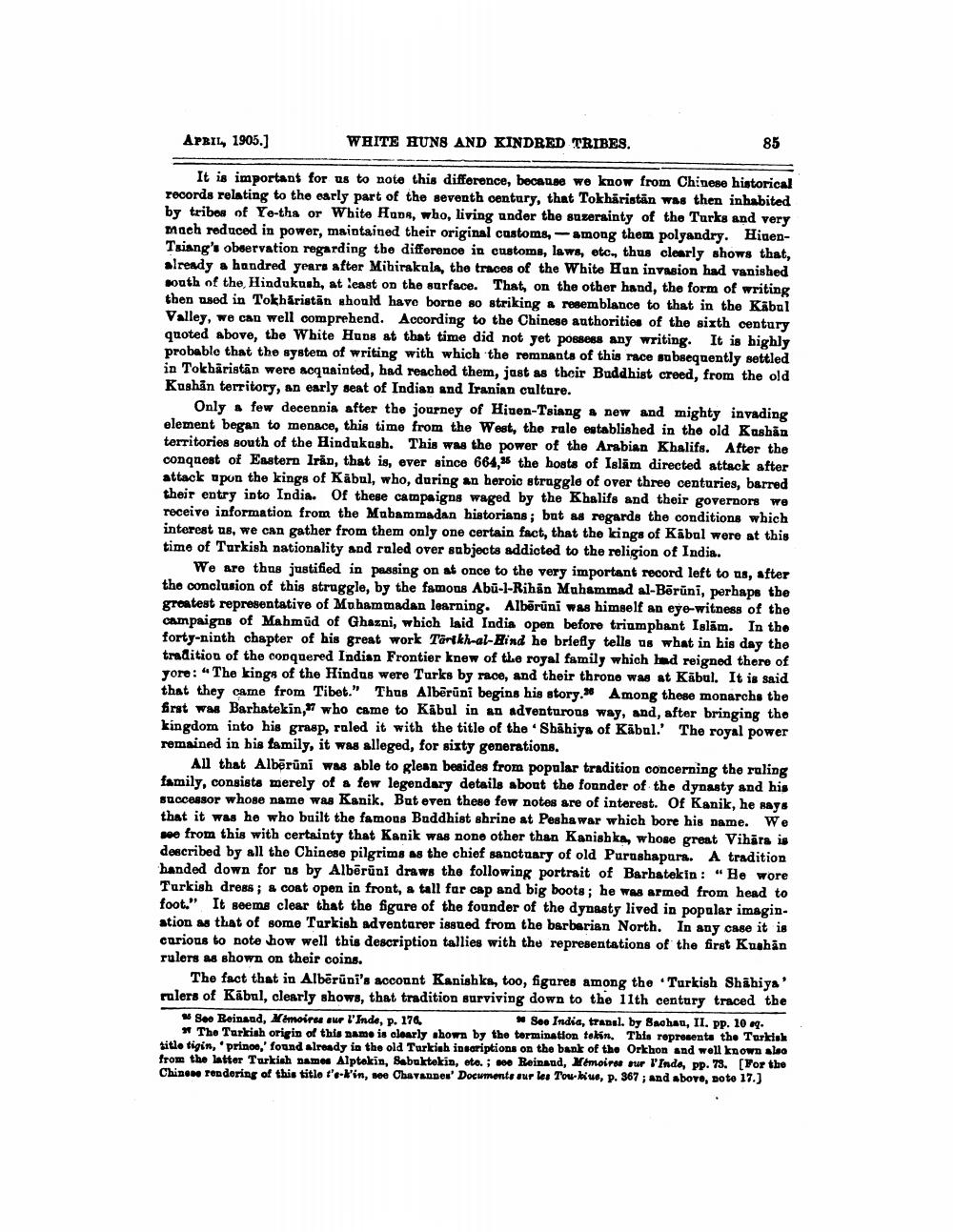________________
APRIL, 1905.]
WHITE HUNS AND KINDRED TRIBES.
It is important for us to note this difference, because we know from Chinese historical records relating to the early part of the seventh century, that Tokharistan was then inhabited by tribes of Ye-tha or White Huns, who, living under the suzerainty of the Turks and very mach reduced in power, maintained their original customs,-among them polyandry. HiuenTsiang's observation regarding the difference in customs, laws, etc., thus clearly shows that, already a hundred years after Mihirakula, the traces of the White Hun invasion had vanished south of the, Hindukush, at least on the surface. That, on the other hand, the form of writing then used in Tokharistan should have borne so striking a resemblance to that in the Kabul Valley, we can well comprehend. According to the Chinese authorities of the sixth century quoted above, the White Huns at that time did not yet possess any writing. It is highly probable that the system of writing with which the remnants of this race subsequently settled in Tokharistan were acquainted, had reached them, just as their Buddhist creed, from the old Kushan territory, an early seat of Indian and Iranian culture.
85
Only a few decennia after the journey of Hiuen-Tsiang a new and mighty invading element began to menace, this time from the West, the rule established in the old Kushän territories south of the Hindukush. This was the power of the Arabian Khalifs. After the conquest of Eastern Iran, that is, ever since 664,5 the hosts of Islam directed attack after attack upon the kings of Käbul, who, during an heroic struggle of over three centuries, barred their entry into India. Of these campaigns waged by the Khalifs and their governors we receive information from the Muhammadan historians; but as regards the conditions which interest us, we can gather from them only one certain fact, that the kings of Kabul were at this time of Turkish nationality and ruled over subjects addicted to the religion of India.
We are thus justified in passing on at once to the very important record left to us, after the conclusion of this struggle, by the famous Abu-l-Rihan Muhammad al-Beruni, perhaps the greatest representative of Muhammadan learning. Alberūni was himself an eye-witness of the campaigns of Mahmud of Ghazni, which laid India open before triumphant Islam. In the forty-ninth chapter of his great work Tartkh-al-Hind he briefly tells us what in his day the tradition of the conquered Indian Frontier knew of the royal family which had reigned there of yore: "The kings of the Hindus were Turks by race, and their throne was at Kabul. It is said that they came from Tibet." Thus Alberūni begins his story. Among these monarchs the first was Barhatekin, who came to Kabul in an adventurous way, and, after bringing the kingdom into his grasp, ruled it with the title of the Shahiya of Kabul.' The royal power remained in his family, it was alleged, for sixty generations.
All that Alberüni was able to glean besides from popular tradition concerning the ruling family, consists merely of a few legendary details about the founder of the dynasty and his successor whose name was Kanik. But even these few notes are of interest. Of Kanik, he says that it was he who built the famous Buddhist shrine at Peshawar which bore his name. We see from this with certainty that Kanik was none other than Kanishka, whose great Vihara is described by all the Chinese pilgrims as the chief sanctuary of old Purushapura. A tradition handed down for us by Alberüni draws the following portrait of Barhatekin: "He wore Turkish dress; a coat open in front, a tall fur cap and big boots; he was armed from head to foot." It seems clear that the figure of the founder of the dynasty lived in popular imagination as that of some Turkish adventurer issued from the barbarian North. In any case it is curious to note how well this description tallies with the representations of the first Kushan rulers as shown on their coins.
The fact that in Alberuni's account Kanishka, too, figures among the Turkish Shahiya' rulers of Kabul, clearly shows, that tradition surviving down to the 11th century traced the See India, transl. by Sachau, II. pp. 10 sq.
5 See Reinand, Mémoires sur l'Inde, p. 176,
The Turkish origin of this name is clearly shown by the termination tekin. This represents the Turkisk title tigin, prince,' found already in the old Turkish inscriptions on the bank of the Orkhon and well known also from the latter Turkish names Alptekin, Sabuktekin, ete.; see Reinand, Mémoires sur l'Inde, pp. 73. [For the Chinese rendering of this title t'e-k'in, see Chavannes' Documents sur les Tou-kiue, p. 367; and above, note 17.]




